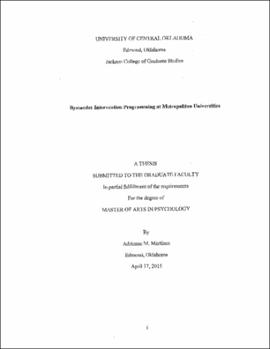| dc.contributor.advisor | Mather, Robert | |
| dc.contributor.author | Martinez, Adrienne M. | |
| dc.date.accessioned | 2020-07-13T18:32:03Z | |
| dc.date.available | 2020-07-13T18:32:03Z | |
| dc.date.issued | 2015 | |
| dc.identifier.other | (AlmaMMSId)9982426484802196 | |
| dc.identifier.uri | https://hdl.handle.net/11244/325219 | |
| dc.description.abstract | The current study reviews the responsibilities and benefits of institutions in receipt of federal funding to provide bystander education as a primary prevention program to students per current federal regulations and guidance. Existing bystander intervention programs have the potential to 1) train key staff by experts; 2) continue training of other staff via train-the-trainer efforts; 3) implement a variety of student-specific programming (such as gender neutral, gender-specific, student athletes, Greek students, and other student organizations and leadership groups); and, 4) obtain/maintain compliance with federal guidance and recent legislative mandates. Per Potter and Stapleton (2011), practitioners need to decide if purchasing an existing program, developed and evaluated at another institution, will in fact be successful at the investing institution. Metropolitan universities typically have student populations of that are older (non-traditional), have lower socioeconomic statuses, have minority backgrounds (Barnett & Phares, 1995); commute, are more likely to be employed (Muhollan, 1995); and, are first-generation college students (Barnett & Phares, 1995). Vast diversity can present challenges to engaging a student body with a one-handed type of approach. Metropolitan universities would be benefited most by 1) purchasing an existing train-the-trainer bystander intervention program; 2) identifying the needs of unique metropolitan university student groups; 3) modifying the program to meet these needs; 4) developing a strategic implementation plan; 5) pre/post assessment plans; and, 6) identifying accompanying social marketing campaign strategies. Considerations for developing a modified bystander intervention program at a metropolitan university and meeting these needs are discussed. | |
| dc.rights | All rights reserved by the author, who has granted UCO Chambers Library the non-exclusive right to share this material in its online repositories. Contact UCO Chambers Library's Digital Initiatives Working Group at diwg@uco.edu for the permission policy on the use, reproduction or distribution of this material. | |
| dc.subject.lcsh | Bystander effect | |
| dc.subject.lcsh | Rape | |
| dc.subject.lcsh | Universities and colleges | |
| dc.subject.lcsh | School violence | |
| dc.title | Bystander intervention programming at metropolitan universities. | |
| dc.type | Academic theses | |
| dc.contributor.committeeMember | Lord, Wayne | |
| dc.contributor.committeeMember | Limke, Alicia, 1979- | |
| dc.thesis.degree | M.A., Psychology | |
| dc.subject.keywords | Bystander Intervention | |
| dc.subject.keywords | Higher Education | |
| dc.subject.keywords | Interpersonal Violence | |
| dc.subject.keywords | Prevention | |
| dc.subject.keywords | Sexual Assault | |
| dc.subject.keywords | Title IX | |
| dc.identifier.oclc | (OCoLC)ocn933920897 | |
| uco.group | UCO - Graduate Works and Theses::UCO - Theses | |
| thesis.degree.grantor | Jackson College of Graduate Studies | |
